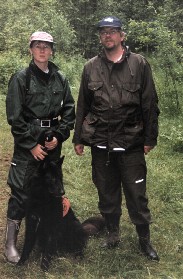Apollo's and Ira's Photo Album:
"Introduction to the Secrets of the
Messenger Dog Trial"
Click a photo for a larger version!
In Finland and Scandinavia all the working dogs in training or in
competition have to wear a symbol indicating that they are "at work".
In these pictures Apollo and Ira wear their Working Dog harnesses.
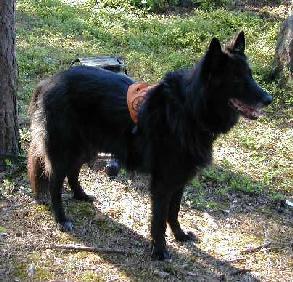
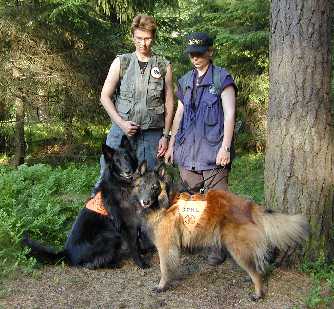
The messenger dog also has to wear a special collar in which they can
"deliver the message". Often this is a normal (old) collar with a small
container attached to it (I personally use film containers).
In the competition, each dog's result slip is carried in the collar,
in this picture you can see the piece of paper from Apollo's collar
where the judge writes the time spent on each leg. When training,
the "message" can contain instructions from one handler to the other.
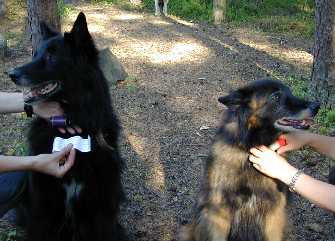
Even though the dog runs from one handler to the other because he loves
them both and he enjoys this form of exercise, there has to be some other
motivation also. Many handlers give their dogs treats when they arrive
to the handler (this is allowed also in trials, even though in Finnish
obedience trials it is strictly forbidden!), or they play tug or retrieve
with the dog, whatever the dog enjoys!
Apollo loves treats! Here Merja prepares a bowl of treats (hot dog)
to give to Apollo when he reaches her.
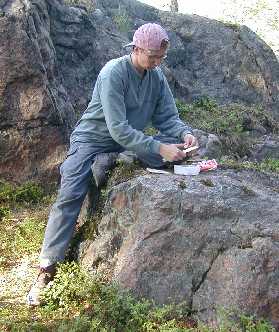
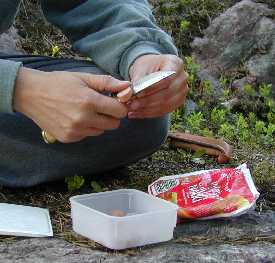
Well, Apollo does love tennis balls as well... It's great to have a dog
who is so easily motivated, he does almost anything for a treat _and_
for a tennis ball!
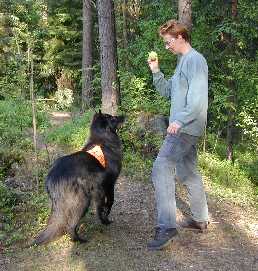
When the trial starts, each dog's handler draws a number that they
use troughout the trial. Then the dogs with their handlers H2 leave the
handlers H1, walking trough the forest following one of the two judges
(another judge
remains with the handlers H1). At this point
the dogs are in reverse order: In our example here Ira is assgined Number
2, Apollo is Number 1. There could be many more dogs in addition to these two!
When the dogs and the handlers H2 leave the handlers H1, the H1 handlers
can call their dogs ("Bye-bye, I'm staying here!" or whatever they want
to say). Then the handlers H1 sit back and relax at their waiting position A.
(And more often than not, drink coffee.) As you can see, the handlers H1
do not really get any exercise during this trial, whereas the handlers H2
must walk all the way to the waiting position B and then later continue
to the waiting position C, and the dogs of course get to do all the
running back and forth! Thus the lazy handlers prefer to stay at position A
whereas the more sports-oriented go into the forest...
In these photos Anna and Ira (Number 2) and Merja and Apollo (Number
1) proceed from position A to position B. All the dogs and handlers
must walk in line (in order not to mess up the track that the dogs
need to pick up when returning), the dogs are on leash at this point
and everybody is supposed to be silent.
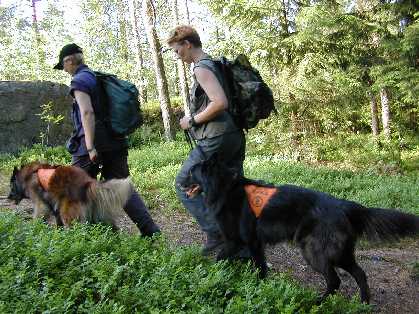
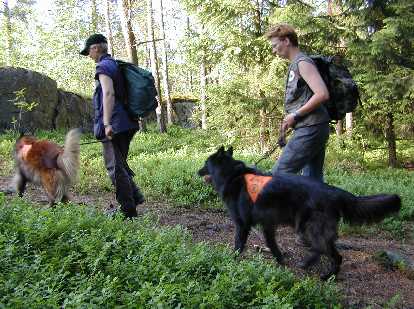
At the waiting position B all the handlers H2 tie their dogs to a tree
etc., still remaining in a line formation (still in order not to mess
up the track, because they will later continue to the position C) and
sit down with their dogs.
Here Anna and Ira are silently waiting. Ira would like to go running
already!
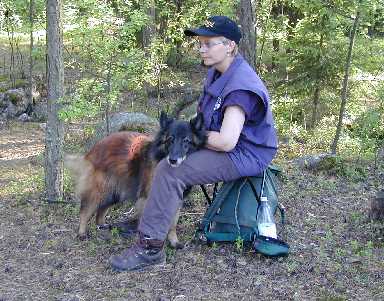
At this point the judge starts calling out starting times for
each dog. When all the handlers are ready and have "camped" with their
dogs, there will be at least 5 minutes of waiting before the first
dog is sent to run. After that, each dog is sent 3 minutes after the
previous one.
In our example here the judge calls out to Merja and Apollo (Number 1)
"It's your turn in 5 minutes!". Then it's up to Merja what she wants to
do next, but according to the rules the start time is fixed, the dog
must wait in a heel position at the waiting line at least 30 seconds
before the handler can give the command, and the dog must heel the
handler (off-leash at the higher level trials) for 25 metres before they
arrive to the starting line.
Sounds complicated? Let's look at our example!
When the judge calls to Merja "Your turn in 5 minutes", Merja silently
takes off Apollo's leash and whispers to the dog "Would you like to
go and find Tepe!" etc. Then she waits for the judge's 2-minute
signal. She stands up, asks Apollo to heel, and walks back and forth
at her waiting position just to make sure Apollo heels properly and
is well motivated. The judge next calls: "One minute!" and then Merja
asks Apollo to heel, and walks to the starting line.
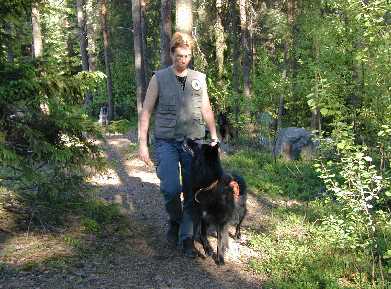
When they reach the starting line they still have 43 seconds before
the starting signal. That's fine -- they must spend at least
30 seconds at the starting line -- if they had arrived late, they
would have to spend the 30 seconds there anyway, i.e. this would be
added as "penalty" to the dog's running time.
Apollo sits and waits for Merja's command. The judge looks at his
watch counting the seconds and is almost ready to give the permission to run...
Also here the dog must be silent! Remember, the Finnish army used messenger
dogs during the war and they had to be silent so that the Russians
would not notice them, and we still respect this old tradition.
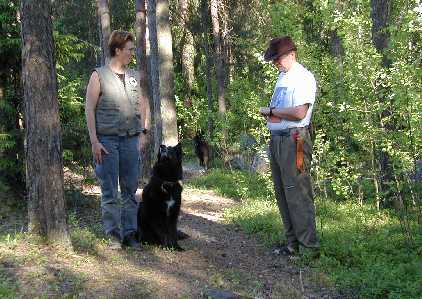
Judge: "Five, four, three, two, one, OK!".
Merja: "Run!"
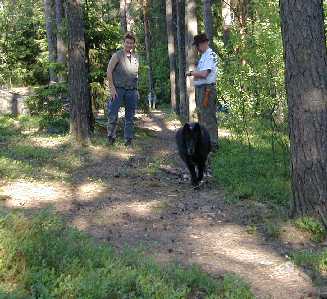
Apollo leaves at full speed without looking back -- wonderful!
However, Merja stays at the starting line for one minute. If the dog
would return, she would be allowed to give new commands to the dog for
one minute, after that, they automatically fail if the dog returns
without reaching the other handler first.
Nothing happens for one minute. Merja silently goes back to her "camp",
next to which Anna and Ira are getting ready.
Anna has 1.5 minutes to go! She already has taken Ira off-leash and now gives
her the command to heel. They start proceeding to the staring line...
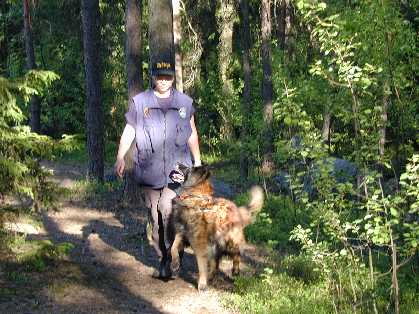
Waiting for at least 30 seonds again...
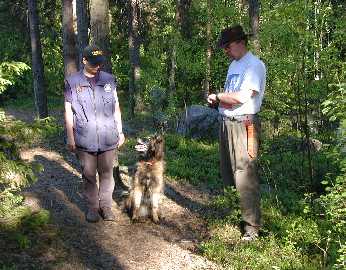
"Five, four, three, two, one, OK."
Anna: "Run!"
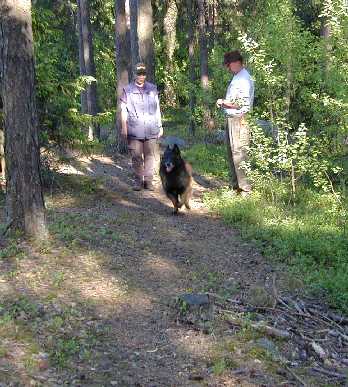
Ira runs, without looking back! But also Anna wants to wait for one
minute just to be sure...
Then we could have more dogs, each following the previous one after
3 minutes. But in our example we only have these two dogs, so now
the painful waiting starts...
After some minutes the judge establishes a contact with the other
judge on his walkie-talkie. He mumbles something... then: "Everything is
fine, both dogs have reached position A! We can leave now!"
The judge and the handlers H2 walk onward, leaving the position B and
proceeding to position C several hundred meters ahead. There the
handlers once again put down their gear, but now they can spread all
over the place instead of having to be in a line formation, because the
dogs do not have to track from here on.
At the same time, handlers H1 are getting ready at position A!
Apollo is the first one to go again (the order remains the same
troughout the trial, except if one dog refuses to run or returns
too early). Apollo heels Tepe to the starting line, where they wait
for at least 30 seconds, and then Apollo is given the command to run!
Apollo runs... he reaches position B where the handlers and the dogs
were earlier. Where is everybody??? Apollo starts tracking, there is
a strong scent of several people that he can easily follow while still
running...
Merja is already standing at the finish line. The judge has given her
instructions: "When you see your dog passing the big tree 50 meters from
here, you can call him!"
Apollo is approaching! Merja is happily yelling his name: "Apollooooo,
goooood boooooy!!!"
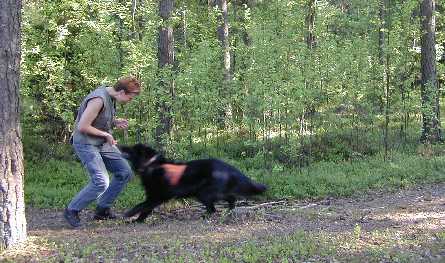
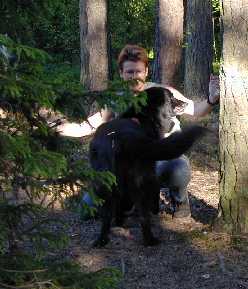
Merja gives Apollo some treats and takes him to where she left her
backpack. Anna is already standing at the finishing line getting ready
for Ira ...
Soon enough Ira also appears! "Gooood giiiiiirl!"
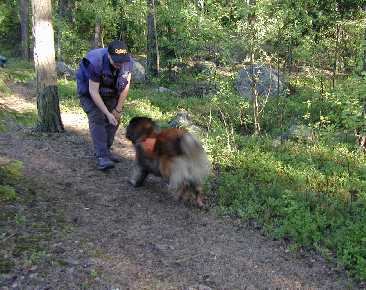
It is also possible that the dogs arrive in a different order than
the one in which they left! Or sometimes, unfortunately, they do not arrive
at all because they have returned to the other handler.
Sometimes several dogs arrive together, running as a pack...
All the dogs are now at position C. The first thing to do is to give them
some water to drink: the dogs are probably thirsty from running, but it is
also very important that they know that they always get water from
their handler, so that they will not start looking for water while running!
Apollo is thirsty!
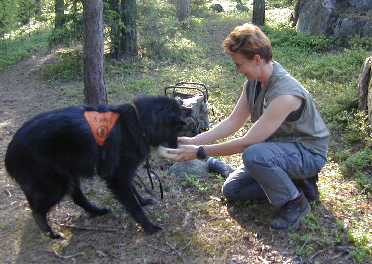
Then the dogs are supposed to relax...
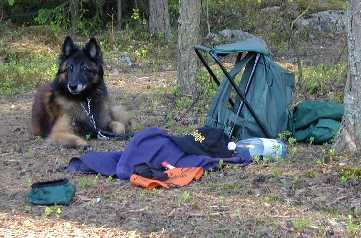
Some dogs relax better with their owners...
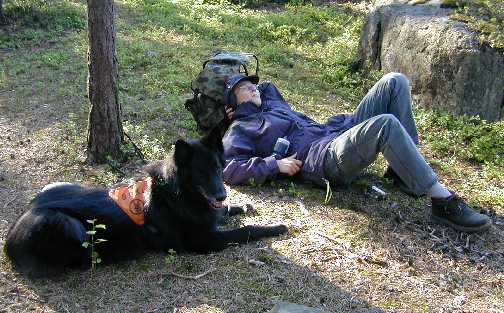
At the highest level (VOI) the dogs must return to position A again,
then run all the way to position C, and then once more return to position A!
This means the total of 7.2 km (4.5 miles) of running! (In the pre-2000
rules it was slightly more, 8.0 km (5 miles)). The allowed maximum time at
the highest level is 44 minutes, after that the dog fails, and the
ideal time is less than 25 minutes.
The faster the dog runs, the more points he gets. Points are reduced
if the dog barks or whines at the waiting positions, does not heel
properly or otherwise does not behave properly.
That was it!
We hope that you enjoyed learning the basics of the
messenger dog trials with us!
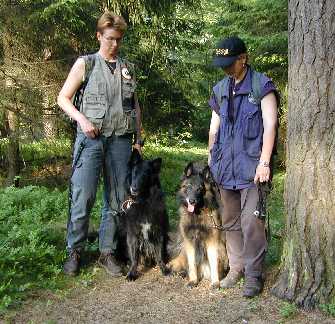
Merja & Apollo, Anna & Ira
Updated: 2004-01-21 / mtt.
